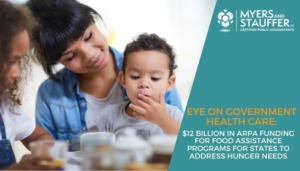
The next installment of our series on the American Rescue Plan Act (ARPA) of 2021 focuses on investments made to nutrition programs. The ARPA includes $12 billion in investments to food assistance programs to address hunger needs during the COVID-19 public health emergency. Key investments include:
- $3.5 billion to extend the 15% increase to monthly benefits under the Supplemental Nutrition Assistance Program (SNAP) through September 30, 2021 (from June 30, 2021).
- $1.135 billion allocated to states for SNAP administration, in addition to the $1 billion for grants for nutrition assistance programs for U.S. territories. This funding is in response to increased SNAP benefit demand. The USDA plans to distribute $245 million to states in FY 2021 and $445 million in FY 2022 and FY 2023. The funds will be used to make investments in state administrative processes and technology to address the following goals:
-
- Improved client access to SNAP through online applications, benefit management tools, text messaging, and ensuring all client access is mobile enabled.
- Expanded call center capacity and reduce call center wait times.
- Modernization of customer service delivery through investments in technological infrastructure and state employee training.
- Evaluation of opportunities to improve service delivery and access to vulnerable populations impacted by remote operations, language barriers, and a lack of access to technology.
- Improved reporting systems to ensure timely and reliable information is provided to USDA Food and Nutrition Services (FNS), congress, and stakeholders on program outcomes and activities, including major systems changes.
- Revise SNAP webpages, instructions, and guidance to ensure program information is easy to find, clear, concise, and provided in the required languages.
- $490 million allocated to the USDA to increase the amount of the cash-value voucher provided under the Special Supplemental Nutrition Program for Women, Infants, and Children (WIC).
- Participating states can apply the increase for as long as four months, but only until the funding expires on September 30, 2021.
- $390 million provided to increase participation in WIC through outreach and program modernization.
- Temporarily allows homeless young adults ages 18 through 24 to receive meals and snacks under the Child and Adult Care Food Program (CACFP), as long as they reside in or receive services from shelters participating in the CACFP. Access to these benefits will remain in effect for the duration of the COVID-19 public health emergency at an estimated cost of $180 million.
- $5.5 billion to extend the Pandemic Electronic Benefit Transfer program through any school year or summer period following a designated public health emergency. The program provides food aid to families during school closures.
The expansion of food assistance benefits and the associated state administrative funding represents a significant opportunity for states to support increased demand for benefits and improve their nutrition program operations, eligibility systems and program oversight. Myers and Stauffer has extensive experience advising health and human services agencies on eligibility system issues, eligibility determination processes, the data used to determine or verify eligibility, benefit oversight and the resulting data maintained within the various systems. We have performed eligibility and benefit compliance reviews, audits, and data analyses for federal, state, and local government clients for almost 20 years.
If you would like to hear more information about how Myers and Stauffer can help states administer and monitor their food assistance programs please contact us.
Contact the Contributors:
| Michael Johnson, CPA Member mjohnson@mslc.com |
Megan Wyatt Senior Manager mwyatt@mslc.com |



